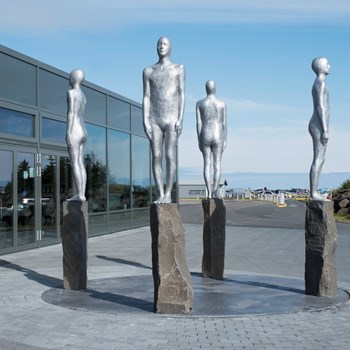
Directions (Áttir)
Directions (“Áttir”) is a sculptural installation by Steinunn Þórarinsdóttir (born in 1955). It features four human-like figures all cast in aluminium from the same mould. Standing on Icelandic basalt columns, each figure faces one of the four cardinal directions. The sculpture is about three metres high and stands within a three-metre diameter circle. If the circle is envisioned within a square, this gives the piece the dimensions 3m x 3m x 3m. Directions was unveiled at the inauguration of the Leifur Eiriksson Air Terminal in April 2007 following extensive renovations. Itoriginally stood in the terminal’s commercial area, but was relocated outside the arrivals hall in consultation with the artist in June 2017.
The sculptor has said of the work: “Of course, the piece strongly suggests travel by pointing in the four cardinal directions. It also refers to the fact that we can all lose direction in life, at which point it becomes necessary to find the right way.”
Artist’s website: www.steinunnth.com
.
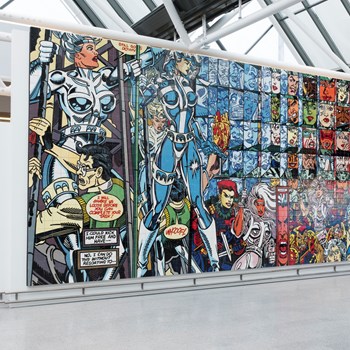
Silver sabler
This work by Icelandic postmodern artist Erró (born in 1932) is a mural of hand-painted ceramic tiles. It is a replica of a painting of the same name dating from 1999, here enlarged to a ceramic version of 11 x 4.5 metres. The piece partly deals with the legends of the skies, the rootlessness of modern life and the air terminal as a place of adventurous possibilities.
It was installed in 2017 in the terminal’s commercial area.
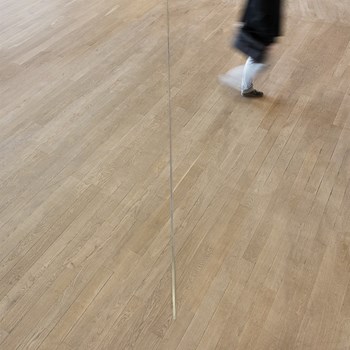
Rift (Flekaskil)
The installation piece Rift (“Flekaskil”) is by Icelandic artist Kristján Guðmundsson (born in 1941). It symbolises the boundary between the North American and Eurasian tectonic plates, which runs across Iceland from the southwest to the northeast of the country. It is a floor installation consisting of a 15-metre long line made of stainless steel, which is inlaid into the oak floor on Level 1 of the terminal’s south building. The direction of the line marks the general orientation of the plate boundary. The line’s width of 2 cm is equal to the rate at which the gap between the North American and Eurasian landmasses is widening each year in Iceland.
Rift is one of a number of pieces selected in an artworks competition during the construction of the terminal’s south building.
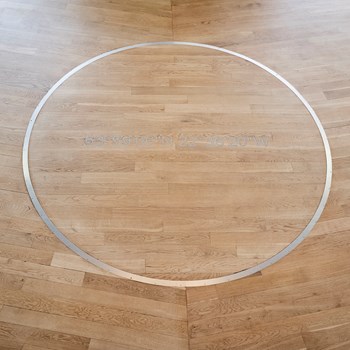
Reference point (Tilvísunarpunktur)
Reference Point (“Tilvísunarpunktur”) is also by Kristján Guðmundsson. This piece refers to the location where Keflavik Airport’s runways intersect, expressed in latitude and longitude. At the centre of the piece is an inscription of geographic coordinates made of stainless steel, which is inlaid into the oak floor on Level 2 of the terminal’s south building. The inscription is enclosed in a stainless-steel circle with a diameter of 250 cm and a line width of 5 cm. Notches in the circle represent the four cardinal directions.
Rift is one of a number of pieces selected in an artworks competition during the construction of the terminal’s south building.
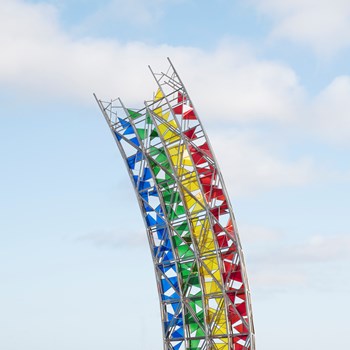
Rainbow (Regnbogi)
by Rúrí
Rainbow (“Regnbogi”) is by Icelandic artist Rúrí (born in 1951). The sculpture stands in front of the terminal’s northern facade. Extending 24 metres into the sky, Rainbow is the tallest work of art in Iceland. It is made of square-shaped, stainless-steel tubes and stained glass. The rainbow’s colours are composed of 313 yellow, red, green and blue stained glass units. The sculpture rises from a base of Icelandic dolerite rock and is lit up at night. The artist has said of the piece: “The rainbow is an unfinished construction – I like to imagine that perhaps one day, in a hundred or a thousand years, somebody will pick up where I left off and continue the work. It will then climb skywards higher and higher before starting its descent, until at last touching the earth and thereby completing the rainbow.”
Rainbow is one of two pieces to win first prize in a competition to select outdoor sculptures at the Leifur Eiriksson Air Terminal held shortly after its inauguration. The sculpture was constructed in 1991.
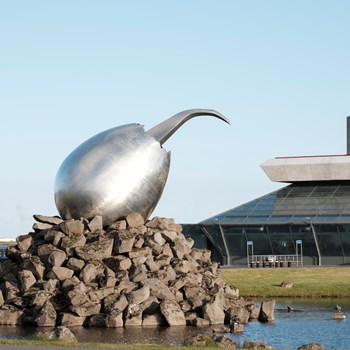
The jet nest (Þotuhreiður)
by Magnús Tómasson
The Jet Nest (“Þotuhreiður”) is by Icelandic artist Magnús Tómasson (born in 1943). The sculpture shows a large egg from which a “new-born” jet aircraft is hatching like a bird’s young. The steel egg is perched on a nest of rocks. The artist, Magnús Tómasson, says the idea for the piece was born many years ago: “I was working on a series on the history of birds, which included a small hen’s egg with a beak poking out. I developed this idea further and the result is The Jet Nest, my largest piece.” The sculpture stands at a total height of about 9 metres in the centre of a lit-up pond at the terminal’s north side. The stainless-steel egg is 5.6 metres tall, 4.2 metres wide and weighs more than five tonnes. The nest of rocks on which the egg is positioned is 14 metres in diameter and the pond covers an area of 1,800 square metres.
The Jet Nest is one of two pieces to win first prize in a competition to select outdoor sculptures at the Leifur Eiriksson Air Terminal held shortly after its inauguration.
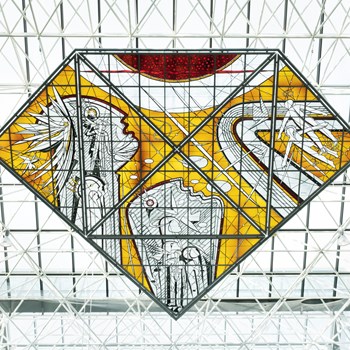
Flugþrá (Yearning for Flight)
by Leifur Breiðfjörð
Leifur Breiðfjörð, a distinguished Icelandic artist born in 1945, brings to the terminal a mesmerizing vision with "Yearning for Flight" ("Flugþrá"). This magnificent stained glass artwork is one of a pair adorning our space, masterfully crafted in a kite-like shape to seamlessly integrate with the terminal's architectural design. The artwork's intricate combination of opal, yellow, and opaque glass panes form a captivating display, especially when illuminated at night, creating a dynamic interplay of light and color.
Measuring an impressive 720 x 970 cm, "Yearning for Flight" is prominently showcased in the departure hall, gracing the north window with its awe-inspiring presence.
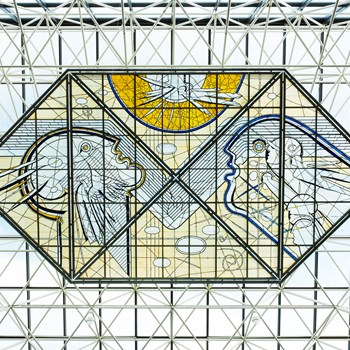
Íkarus (Icaros)
by Leifur Breiðfjörð
Leifur Breiðfjörð, a renowned Icelandic artist, presents "Íkarus" (Icaros), a remarkable stained glass creation that adorns the terminal. This piece, alongside its counterpart "Yearning for Flight," forms a duo that eloquently expresses humanity's age-old aspiration to soar through the skies. "Íkarus" delves into the timeless tale of Icarus, juxtaposing this ancient myth with the modern-day feats of astronauts and the natural grace of birds. The artwork becomes a luminous spectacle at night, a beacon of dreams and human ingenuity.
"Icaros" spans an impressive 490 x 970 cm and is beautifully situated in the departure hall, overlooking the south window, offering a captivating visual experience to travelers.
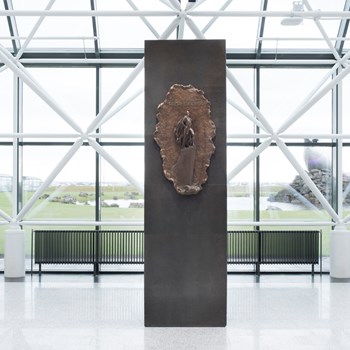
Bas-relief of Leifur Eiríksson
by Ívar Valgarðsson
Created by Icelandic artist Ívar Valgarðsson, this bas-relief echoes Alexander Calder’s memorial statue of the Viking explorer Leifur Eiríksson. Vigdís Finnbogadóttir, the first democratically elected female president in the world, unveiled this piece during the terminal’s inauguration. It celebrates Leifur Eiríksson, the first European known to have discovered the Americas, and is proudly displayed on a 2.8-meter tall triangular pillar of dolerite rock.
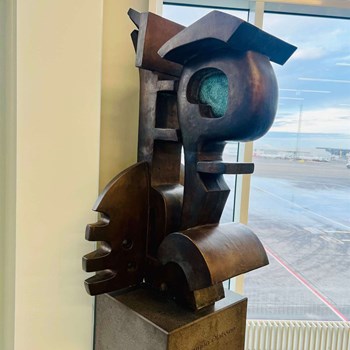
Ég bið að heilsa (I send greetings)
by Sigurjón Ólafsson
This piece by Icelandic sculptor Sigurjón Ólafsson (1908-1982) draws its title from a poem by one of Iceland’s most cherished poets, Jónas Hallgrímsson (1807-1845). The abstract form of the sculpture is a delicate allusion to lines in Hallgrímsson’s poetry, capturing the essence of the Icelandic landscape and the intimate greetings sent by the poet. Acquired in 1988, this bronze cast, one of three, embodies the emotional exchanges of greetings at the terminal.
Learn more at the Sigurjón Ólafsson Museum’s website: www.lso.is
